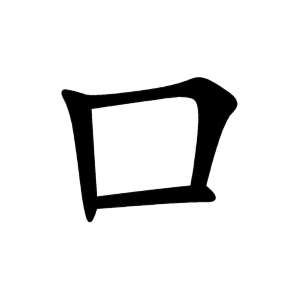口
- mouth;
- opening, orifice;
Etymology
It is a pictograph modeled after the shape of a mouth. 口 basically means “mouth,” but across different languages, its meanings have expanded to include hole, speech, to speak, door, entrance, population, and other variations.
Characters with 口
5 strokes
6 strokes
- 各–each, every, each one individually
- 合–to combine, to unite, to put together, to gather, to collect
- 吉–auspicious, fortunate, lucky
- 同–same, together, collective
- 名–name
- 后–sovereign, monarch, queen, empress
- 吏–official, functionary, clerk
- 吐–to spit, to spew from the mouth
- 向–to face, to turn toward
- 吸–to inhale, to suck in, to drink, to absorb, to smoke (as in cigarettes)
7 strokes
8 strokes
9 strokes
10 strokes
- 員–person, member, personnel, official, office-holder, to add, to increase (archaic sense)
- 哭–to cry, to weep, to wail, to lament
- 哲–bright, wise, sagacious
- 唆–to instigate, to provoke, to incite, to entice
- 唐–The Tang dynasty (618–907 CE) of China, to be flustered, embarrassed, confused, to boast, to talk loudly, to brag
11 strokes
12 strokes
13 strokes
14 strokes
20 strokes
22 strokes
口
입
구
ip
gu
Kangxi radical:30
Strokes:3
Unicode:U+2F1D
Cangjie input:
- 口 (R)
Composition:
- ⿱ 冂 一
